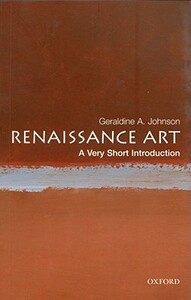Take a photo of a barcode or cover
gringoley's review
4.0
This is really a good book for learning about a subject I knew very little about.
"‘Renaissance’, is also more complex than may appear at first glance. The word literally means ‘rebirth’, but has come to be associated more generally with revival and innovation But if we want to use the concept historically, rather than metaphorically, we need to ask when and how it was first deployed."
"‘Renaissance’, is also more complex than may appear at first glance. The word literally means ‘rebirth’, but has come to be associated more generally with revival and innovation But if we want to use the concept historically, rather than metaphorically, we need to ask when and how it was first deployed."
a_duck_with_a_book's review
5.0
Geraldine Johnson (art historian, University of Oxford) introduces readers to Renaissance Art. Like other entries in the VSI series, this book is supercritical but incredibly helpful to anyone new to the field. The introduction sets up the reader to the historiography of Renaissance art history, following this with chapters dedicated to the altarpiece, narrative art, humanism and the influence of the Classical world, portraiture, women in the Renaissance, public squares and displays, and the impact of the Renaissance genius.
lihatlah's review against another edition
3.0
bagi orang eropa, babak yang disebut renaissance itu bener-bener ada. punya awal dan akhir, dapat diterangkan kapan dan di mana bermula dan ke mana menyebar. babak renaissance ini bagi kebanyakan orang dianggap sudah "jadi", sudah "selesai" sebagai unit peristiwa.
tapi buku ini melonggarkan anggapan itu. kapan dan di mana bermula sengaja dikaburkan. tidak bisa dipastikan, misalnya di kota florence, ketika keluarga medici berkuasa di sana.
renaissance di buku ini masih menempatkan seni sebagai ranah sentral dalam babak sejarah eropa yang dinamai renaisasnce ini. perubahan-perubahan dan inovasi di bidang peralatan [navigasi, pertahanan, transportasi, komunikasi...dst.] kurang mendapat perhatian. padahal, bagaimana sebuah gerakan sosial yang historis dapat berlangsung bila hal-hal material itu tidak terlibat?
ditulis oleh seorang perempuan, maka ia juga menyisipkan pertanyaan "apakah renaissance juga dialami oleh para perempuan?". sebuah pertanyaan masa kini yang diajukan pada masa lalu yang dianggap sudah jadi. akibatnya, babak renaissance itu pun mengalami pengayaan tafsiran.
semua uraian disajikan secara singkat dan padat.
pada hemat saya, ini cocok untuk memberi gambaran awal mengenai bagaimana babak historis renaisasnce ini ditetapkan batas-batasnya, dan apa saja yang menarik dipetik dari sana untuk masa kini.
tapi buku ini melonggarkan anggapan itu. kapan dan di mana bermula sengaja dikaburkan. tidak bisa dipastikan, misalnya di kota florence, ketika keluarga medici berkuasa di sana.
renaissance di buku ini masih menempatkan seni sebagai ranah sentral dalam babak sejarah eropa yang dinamai renaisasnce ini. perubahan-perubahan dan inovasi di bidang peralatan [navigasi, pertahanan, transportasi, komunikasi...dst.] kurang mendapat perhatian. padahal, bagaimana sebuah gerakan sosial yang historis dapat berlangsung bila hal-hal material itu tidak terlibat?
ditulis oleh seorang perempuan, maka ia juga menyisipkan pertanyaan "apakah renaissance juga dialami oleh para perempuan?". sebuah pertanyaan masa kini yang diajukan pada masa lalu yang dianggap sudah jadi. akibatnya, babak renaissance itu pun mengalami pengayaan tafsiran.
semua uraian disajikan secara singkat dan padat.
pada hemat saya, ini cocok untuk memberi gambaran awal mengenai bagaimana babak historis renaisasnce ini ditetapkan batas-batasnya, dan apa saja yang menarik dipetik dari sana untuk masa kini.
cultural_detritus's review
4.0
I have enjoyed several books from this series, but this one is my favorite. The author treats Renaissance art with respect, but doesn't elevate it as the greatest artistic achievements ever, as many commentaries do. In fact, the author explicitly examines the idea of the artist-as-rockstar, which we take for granted today, but didn't really exist before the Renaissance. Instead, she tells a story of power and civic rivalry--the contexts that produced much of what we consider high renaissance art. My only real critiques of this book is that it didn't spend that much time discussing the Northern Renaissance, and the book lack footnotes and other forms of marginalia that would have helped to substantiate its claims.
gobblebook's review
4.0
Does just what it sets out to do - provides a very short introduction to the topic. Nothing profound, but it's a good starting point.
rmtbray's review
4.0
A good overview of the issues surrounding Renaissance art, illustrated with examples and case studies of artworks, artists, or even cities, rather than a summary of main artists, styles and centres of art etc. I found this more useful for my purposes but it might not be right for other people. The only thing I found annoying were the patronizing conclusions to each chapter, really could have done without them!
